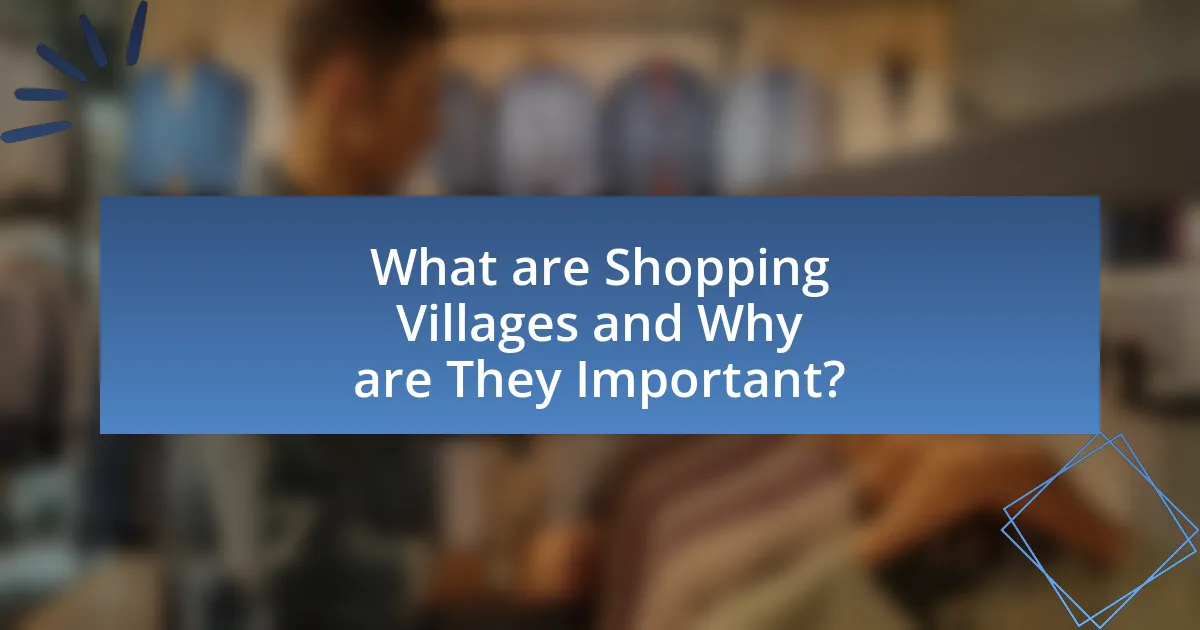Shopping villages are retail destinations that combine shops, restaurants, and entertainment in an outdoor setting, designed to enhance the shopping experience and boost local economies. This article explores successful case studies of shopping villages worldwide, such as Bicester Village in the UK and Woodbury Common Premium Outlets in the USA, highlighting their unique features, community engagement, and economic contributions. It also examines the factors that contribute to their success, including strategic location, diverse retail offerings, and innovative marketing strategies, while addressing trends shaping the future of shopping villages, such as sustainability and digital integration.

What are Shopping Villages and Why are They Important?
Shopping Villages are retail destinations that combine a variety of shops, restaurants, and entertainment options in an outdoor or semi-outdoor setting, often designed to resemble a quaint village atmosphere. They are important because they enhance the shopping experience by providing a unique environment that encourages social interaction, leisure, and tourism, which can significantly boost local economies. For instance, studies have shown that shopping villages can increase foot traffic and sales for local businesses, as they attract both residents and tourists seeking a diverse shopping experience in a pleasant setting.
How do Shopping Villages differ from traditional shopping centers?
Shopping Villages differ from traditional shopping centers primarily in their design and shopping experience. Shopping Villages are typically designed to resemble quaint, outdoor marketplaces with a focus on aesthetics and ambiance, often featuring unique architecture and landscaping, while traditional shopping centers are usually large, enclosed spaces with a more utilitarian layout. Additionally, Shopping Villages often emphasize a curated selection of boutique shops and local artisans, promoting a sense of community and exclusivity, whereas traditional shopping centers tend to host a wider range of chain retailers and standardized stores. This distinction is supported by the fact that many successful Shopping Villages, such as Bicester Village in the UK, attract visitors not just for shopping but for the overall experience, including dining and leisure activities, which is less emphasized in conventional shopping centers.
What unique features define a successful shopping village?
A successful shopping village is defined by its unique blend of community engagement, diverse retail offerings, and a welcoming atmosphere. Community engagement fosters a sense of belonging, encouraging local events and activities that draw visitors. Diverse retail offerings, including a mix of independent boutiques and essential services, cater to various consumer needs, enhancing foot traffic. A welcoming atmosphere is created through pedestrian-friendly design, attractive landscaping, and amenities such as seating areas, which promote longer visits. These features collectively contribute to the vibrancy and sustainability of shopping villages, as evidenced by successful examples like the Village at Corte Madera in California, which combines these elements to attract a loyal customer base.
How do shopping villages contribute to local economies?
Shopping villages contribute to local economies by generating employment, attracting tourism, and increasing local tax revenues. Employment opportunities arise from the diverse range of shops and services offered, which often require a significant workforce. For instance, a study by the International Council of Shopping Centers found that shopping centers, including villages, create approximately 1.5 million jobs annually in the United States alone. Additionally, shopping villages attract tourists, who spend money on local businesses, further stimulating economic growth. According to the National Association of Realtors, retail developments can increase local tax revenues by up to 20%, providing essential funding for community services. Thus, shopping villages play a vital role in enhancing the economic vitality of their surrounding areas.
What factors contribute to the success of shopping villages?
The success of shopping villages is primarily driven by their unique blend of location, diverse retail offerings, and experiential shopping environments. Strategic locations near urban centers or tourist attractions enhance foot traffic, while a mix of retail options, including local artisans and well-known brands, caters to a broad audience. Additionally, creating an engaging atmosphere through events, dining options, and community spaces fosters customer loyalty and encourages longer visits. For instance, the success of Bicester Village in the UK can be attributed to its proximity to London, a variety of luxury brands, and a focus on providing a pleasant shopping experience, evidenced by its annual visitor numbers exceeding 6 million.
How does location influence the viability of a shopping village?
Location significantly influences the viability of a shopping village by determining accessibility, foot traffic, and demographic alignment. A prime location near major transportation routes or urban centers enhances visibility and attracts more visitors, which is crucial for sales. For instance, shopping villages situated in high-density residential areas often experience higher patronage due to the convenience for local residents. Additionally, proximity to complementary businesses, such as restaurants or entertainment venues, can create a synergistic effect that boosts overall traffic. Research indicates that shopping centers located within a 10-minute drive of residential neighborhoods see a 30% increase in customer visits compared to those further away. Thus, strategic location selection is essential for the success and sustainability of shopping villages.
What role does community engagement play in the success of shopping villages?
Community engagement is crucial for the success of shopping villages as it fosters a sense of ownership and loyalty among local residents. When community members actively participate in the planning and development of shopping villages, they are more likely to support local businesses and frequent the area, leading to increased foot traffic and sales. For instance, a study by the International Council of Shopping Centers found that shopping centers with strong community ties saw a 20% increase in customer visits compared to those without such engagement. This demonstrates that community involvement not only enhances the shopping experience but also contributes to the economic vitality of shopping villages.

What are Some Notable Case Studies of Successful Shopping Villages?
Some notable case studies of successful shopping villages include Bicester Village in the UK, which attracts over 6 million visitors annually and features luxury brands at discounted prices, and Woodbury Common Premium Outlets in New York, which sees around 12 million visitors each year and offers a wide range of designer outlets. Additionally, La Vallée Village near Paris has successfully integrated local culture and tourism, drawing in visitors with its proximity to Disneyland Paris and a unique shopping experience. These shopping villages demonstrate effective strategies in attracting high foot traffic and enhancing customer experience through brand diversity and location advantages.
What lessons can be learned from the success of the Bicester Village in the UK?
The success of Bicester Village in the UK demonstrates the importance of strategic location, luxury branding, and customer experience in retail. Bicester Village is situated near Oxford, attracting both local and international tourists, which enhances foot traffic and sales. The village features high-end brands at discounted prices, appealing to consumers seeking luxury goods at a value, thus creating a unique shopping proposition. Additionally, Bicester Village invests in creating an exceptional customer experience, including amenities like dining options and events, which fosters customer loyalty and repeat visits. These factors collectively contribute to its success, illustrating that a well-planned retail environment can thrive by aligning with consumer desires and enhancing the shopping experience.
What strategies did Bicester Village implement to attract visitors?
Bicester Village implemented several strategies to attract visitors, including luxury brand partnerships, exclusive discounts, and a focus on experiential shopping. The village collaborates with high-end brands to offer unique shopping experiences, which enhances its appeal to affluent consumers. Additionally, Bicester Village provides exclusive promotions and discounts, making it an attractive destination for bargain hunters. The emphasis on creating a pleasant shopping environment, complete with dining options and events, further enhances visitor engagement. These strategies have contributed to Bicester Village’s status as a leading shopping destination, evidenced by its consistent visitor growth and high foot traffic.
How has Bicester Village adapted to changing consumer behaviors?
Bicester Village has adapted to changing consumer behaviors by enhancing its digital presence and offering personalized shopping experiences. The shopping destination has implemented an online platform that allows customers to browse and reserve items before visiting, catering to the growing trend of online shopping. Additionally, Bicester Village has introduced services such as personal shopping assistants and exclusive events, which align with consumers’ desires for unique and tailored experiences. These adaptations are supported by data showing that 70% of consumers prefer personalized services, highlighting the effectiveness of Bicester Village’s strategies in meeting evolving consumer expectations.
How has the Woodbury Common Premium Outlets in the USA achieved success?
The Woodbury Common Premium Outlets has achieved success through strategic location, a diverse range of high-end brands, and effective marketing initiatives. Situated near New York City, it attracts both local shoppers and tourists, enhancing foot traffic. The outlet features over 200 stores, including luxury brands like Gucci and Prada, which cater to a wide demographic seeking discounted prices on premium goods. Additionally, the center employs targeted marketing campaigns, including partnerships with travel agencies and promotional events, to draw visitors. These factors collectively contribute to its status as one of the leading outlet centers in the United States, evidenced by its consistent high sales figures and visitor numbers.
What marketing techniques have proven effective for Woodbury Common?
Woodbury Common has effectively utilized a combination of digital marketing, strategic partnerships, and experiential marketing techniques. Digital marketing efforts include targeted social media campaigns that engage potential visitors and promote special events, leading to increased foot traffic. Strategic partnerships with brands and local businesses enhance promotional offerings, such as exclusive discounts and events, which attract shoppers. Experiential marketing, including seasonal events and interactive experiences, creates memorable visits that encourage repeat patronage. These techniques have contributed to Woodbury Common’s reputation as a premier shopping destination, evidenced by its consistent high visitor numbers and sales performance.
How does Woodbury Common maintain a competitive edge in the retail market?
Woodbury Common maintains a competitive edge in the retail market through its strategic location, diverse brand offerings, and significant discounts on luxury goods. Situated near New York City, it attracts both local shoppers and tourists, enhancing foot traffic. The outlet features over 200 stores, including high-end brands like Gucci and Prada, which cater to a wide range of consumer preferences. Additionally, Woodbury Common offers discounts of 25% to 65% off retail prices, making it an appealing destination for bargain hunters. This combination of location, variety, and pricing strategy solidifies its position in the competitive retail landscape.

What Trends are Shaping the Future of Shopping Villages?
The future of shopping villages is being shaped by trends such as experiential retail, sustainability, and digital integration. Experiential retail focuses on creating unique shopping experiences that engage customers beyond traditional purchasing, with many shopping villages incorporating entertainment, dining, and community events to attract visitors. Sustainability is increasingly important, as consumers prefer eco-friendly practices; shopping villages are responding by using sustainable materials and promoting local products. Digital integration involves the use of technology, such as mobile apps and online platforms, to enhance the shopping experience, allowing for seamless transactions and personalized marketing. These trends are supported by market research indicating that 70% of consumers value experiences over products, and 60% are willing to pay more for sustainable goods.
How are technology and e-commerce influencing shopping villages?
Technology and e-commerce are significantly transforming shopping villages by enhancing customer engagement and streamlining operations. Shopping villages are increasingly adopting digital platforms to offer online shopping options, allowing customers to browse and purchase products from local retailers remotely. For instance, the integration of mobile apps and websites enables real-time inventory updates and personalized marketing, which can increase foot traffic and sales. Additionally, data analytics tools help retailers understand consumer behavior, leading to more targeted promotions and improved customer experiences. According to a report by Statista, e-commerce sales are projected to reach $6.54 trillion by 2022, indicating a growing trend that shopping villages can leverage to attract more visitors and boost revenue.
What innovations are being integrated into shopping village experiences?
Innovations being integrated into shopping village experiences include augmented reality (AR) for interactive product displays, mobile payment systems for seamless transactions, and personalized shopping experiences through data analytics. For instance, AR allows customers to visualize products in their own space before purchase, enhancing engagement and decision-making. Mobile payment systems streamline the checkout process, reducing wait times and improving customer satisfaction. Additionally, data analytics enables retailers to tailor offerings based on consumer behavior, leading to increased sales and customer loyalty. These innovations are transforming shopping villages into more dynamic and customer-centric environments.
How are shopping villages adapting to the rise of online shopping?
Shopping villages are adapting to the rise of online shopping by enhancing their in-person experiences and integrating technology. Many shopping villages are implementing click-and-collect services, allowing customers to order online and pick up their purchases at the village, which combines the convenience of online shopping with the experience of visiting a physical location. Additionally, they are hosting events and activities that draw visitors, such as food festivals and artisan markets, to create a unique atmosphere that cannot be replicated online. According to a report by the International Council of Shopping Centers, 70% of consumers prefer shopping in environments that offer experiences beyond just retail, highlighting the importance of experiential offerings in attracting foot traffic.
What sustainability practices are being adopted by successful shopping villages?
Successful shopping villages are adopting sustainability practices such as implementing renewable energy sources, utilizing water conservation techniques, and promoting local sourcing of products. For instance, many shopping villages have installed solar panels to reduce their carbon footprint and reliance on non-renewable energy. Additionally, water-saving irrigation systems and rainwater harvesting are commonly used to minimize water waste. Furthermore, by prioritizing local artisans and producers, these villages not only support the local economy but also reduce transportation emissions associated with goods. These practices contribute to a more sustainable retail environment and align with growing consumer demand for eco-friendly shopping experiences.
How do these practices enhance the appeal of shopping villages to consumers?
Shopping villages enhance their appeal to consumers through unique experiences, diverse retail offerings, and community-focused events. These practices create an inviting atmosphere that encourages longer visits and increased spending. For instance, shopping villages often feature local artisans and specialty shops, which attract consumers seeking unique products not found in traditional malls. Additionally, hosting events such as farmers’ markets or seasonal festivals fosters a sense of community and engagement, making the shopping experience more enjoyable. Research indicates that shopping environments that prioritize customer experience can lead to a 20% increase in foot traffic and sales, demonstrating the effectiveness of these practices in enhancing consumer appeal.
What examples of sustainable initiatives can be found in leading shopping villages?
Leading shopping villages implement various sustainable initiatives, including the use of renewable energy sources, waste reduction programs, and eco-friendly transportation options. For instance, many shopping villages utilize solar panels to power their facilities, significantly reducing their carbon footprint. Additionally, they often engage in comprehensive recycling programs that aim to minimize waste sent to landfills, with some villages achieving over 70% waste diversion rates. Furthermore, initiatives such as electric vehicle charging stations and bike-sharing programs promote sustainable transportation, encouraging visitors to opt for greener travel methods. These practices not only enhance the environmental sustainability of shopping villages but also attract eco-conscious consumers.
What are the best practices for developing a successful shopping village?
The best practices for developing a successful shopping village include strategic location selection, diverse tenant mix, community engagement, and effective marketing. Strategic location selection ensures accessibility and visibility, which are critical for attracting foot traffic; for instance, shopping villages near residential areas or tourist attractions tend to perform better. A diverse tenant mix, including retail, dining, and entertainment options, caters to various customer preferences and enhances the shopping experience, as evidenced by successful models like the Grove in Los Angeles, which combines high-end retail with leisure spaces. Community engagement fosters a sense of ownership and loyalty among local residents, leading to increased patronage; initiatives such as local events and farmer’s markets can strengthen this connection. Finally, effective marketing strategies, including social media campaigns and partnerships with local influencers, can significantly boost awareness and draw visitors, as demonstrated by the success of shopping villages that actively promote their unique offerings.
How can developers ensure community involvement in the planning process?
Developers can ensure community involvement in the planning process by actively engaging local residents through public consultations, workshops, and surveys. These methods allow developers to gather input and feedback directly from the community, fostering a sense of ownership and collaboration. For instance, a study by the American Planning Association found that projects with community engagement resulted in higher satisfaction rates and better alignment with local needs. By incorporating community insights into the planning stages, developers can create spaces that reflect the desires and values of the residents, ultimately leading to more successful and sustainable shopping villages.
What strategies can be employed to create a unique shopping experience?
To create a unique shopping experience, retailers can employ strategies such as personalized customer service, immersive store design, and exclusive product offerings. Personalized customer service enhances engagement by tailoring interactions to individual preferences, which studies show can increase customer loyalty and satisfaction. Immersive store design, incorporating elements like interactive displays and themed environments, captivates shoppers and encourages longer visits, as evidenced by successful implementations in shopping villages like Bicester Village in the UK. Exclusive product offerings, including limited-edition items or collaborations with local artisans, create a sense of urgency and uniqueness, driving foot traffic and enhancing brand perception. These strategies collectively contribute to a distinctive shopping experience that differentiates retailers in a competitive market.


